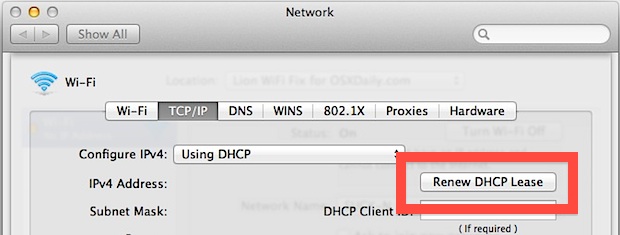Double click it or click Properties. The TCP/IP Properties window will display. Now you have two ways to configure the TCP/IP protocol below: 1. Assigned by DHCP Sever. Select Obtain an IP address automatically and Obtain DNS Server address automatically, as shown in the figure below. These may be selected by default. Then click OK to. Change the “Configure IPv4” entry to “Using DHCP with manual address” and enter your own IP address that is within the router’s subnet (meaning that the first three sets of numbers are. The Mac OS is not seeing or communicating with the DHCP server in the router. Try setting it to manual, and putting in the router/gateway address (192.168.1.1) and a manual address for the Mac (192.168.1.109 for example - whatever is not taken by the other devices.). There are two ways to configure the TCP/IP Properties, Assigned by DHCP server automatically or manually. Assigned by DHCP server Select Obtain an IP address automatically and Obtain DNS server address automatically.
When your LHV / LNR Series DVR / NVR system connects to your router it requires an IP address to communicate with. This IP address can either be automatically assigned by the router, using Dynamic Host Configuration Protocol (DHCP), or can be set by assigning a static IP address to the DVR / NVR. The TCP/IP menu allows you to configure IP address settings.
To configure network type:

- Right-click on the Live View to open the Quick Menu.
- Click Main Menu, then click the Setting icon ().
- Click Network >TCP/IP.
Select DHCP (recommended) to have the system automatically obtain an IP address from the router, or select Static Mavericks dmg google drive. to assign a static IP address.
If selecting Static, configure the following:
IP Address: Enter the IP address to be assigned to the system.
IMPORTANT: Ensure that no other device on the network is using the same IP address.
Subnet Mask: Enter the subnet mask for the network.
Getting dmg from osx installerfocusnew. Default Gateway: Enter the gateway address for the network.
Preferred DNS: Enter the address of your primary DNS server.
Alternate DNS: Enter the address of your secondary DNS server
- Click Apply to save the settings, and then click OK to exit.

Dynamic Host Configuration Protocol, or DHCP for short, is a protocol that enables your MacBook to retrieve all the networking information you need. Before you can use DHCP, you have to add a DHCP server, which provides other computers on the network with their configuration settings.
Most Internet connection-sharing hardware devices (and software-sharing implementations as well) provide a DHCP server as part of the price of admission. (Internet connection sharing allows all your networked computers to access the Internet through a single Internet connection.) Most wired and wireless routers can provide DHCP services these days. Technology marches on.

If you plan to use Internet connection sharing or you know that you have a DHCP server on your network, you can set up your MacBook to automatically obtain the required IP address and information. Open System Preferences from the Dock or the Apple menu and choose Network.
From the Network dialog that appears, click the Ethernet entry in the list on the left. Choose Using DHCP from the Configure IPv4 pop-up menu; then click the Apply button. Mac OS X contacts the DHCP server to obtain an IP address, a subnet mask, a gateway router IP address, and a Domain Name System (DNS) address. (DNS servers convert a human-friendly address to a computer-friendly IP address, like 66.218.71.86.)
A few seconds after clicking the Apply button, you should see the information come up, as provided by the DHCP server. This lets you know that the process worked and configuration is complete. You might also notice that the DNS Servers information is empty (or grayed out).
Fear not: Mac OS X is really using DNS information provided by the DHCP server. Nfl street 3. Press Command+Q to quit System Preferences and save your settings.
Changing Tcp Ip Dhcp From Manual To Automatic On A Mac Os
If you ever make a network change that screws things up, such as entering the wrong subnet mask or an IP address that isn’t in the same range as others on your LAN, you can always click the Revert button to get back your old settings.
Changing Tcp Ip Dhcp From Manual To Automatic On A Macbook Air
One DHCP server on a network is princely, but two or more DHCP servers on a single network will fight like alley cats and grind everything to a halt. Therefore, if you’re considering adding a DHCP server to an existing network, make doggonesure that you’re not treading on another server’s toes. (Ask that network administrator person.)
